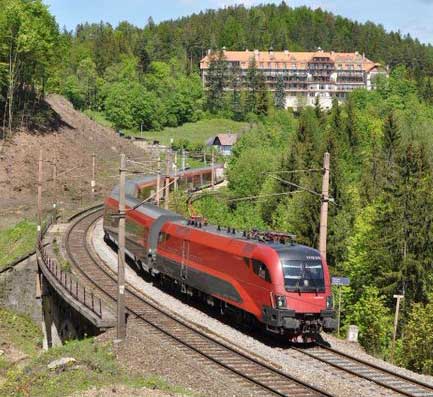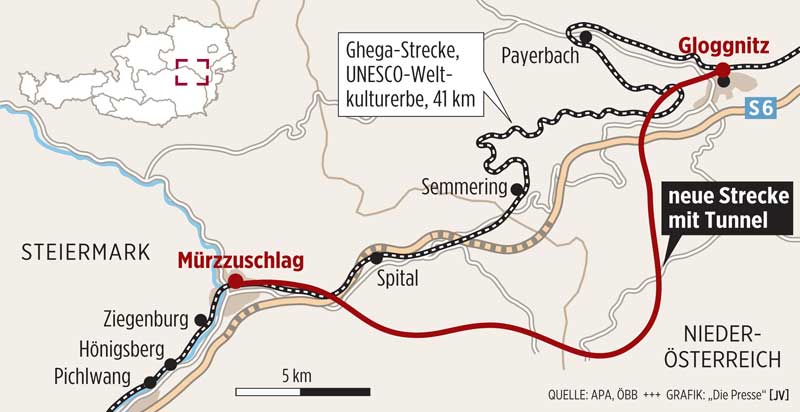The Semmering railway

The Semmering railway in Austria, which starts at Gloggnitz and leads over the Semmering to Murzzuschlag was the first mountain railway in Europe built with a standard gauge track. It is commonly referred to as the world's first true mountain railway, given the very difficult terrain and the considerable altitude difference that was mastered during its construction. It is still fully functional as a part of the Southern Railway which is operated by the Austrian Federal Railways.
The Semmering railway is on the main line between Vienna and Graz, Austria. It only takes about 2.5 hours, but it makes for a fabulous jaunt through the scenic Austrian countryside.
The Route
The Semmering Railway, constructed between 1848 and 1854 over 41 km of high mountains, is one of the greatest feats of civil engineering during the pioneering phase of railway building, and considered the world's first scenic railway. Set against a spectacular mountain landscape, the railway line remains in use today thanks to the quality of its tunnels, viaducts, and other works, and has led to the construction of many recreational buildings along its tracks.
The Semmering Railway officially begins at Gloggnitz station, at an altitude of 436 m, reaches its highest point after 29 km over the pass at 895 m above sea level, and ends 12 km further away at the Murzzuschlag station, 677 m above sea level.
The line can be divided into four sections. The first runs from Gloggnitz to Payerbach stations, following the left-hand slopes of the Schwarza valley; the next section crosses the valley by taking the Schwarza viaduct to reach Eichberg Station, and the third section enters the Auerbach valley to continue through dense forest to Klamm-Schottwien station. After passing through the Klamm Tunnel, it reaches the Adlitzgraben and the Alpine terrain itself.
After a series of tunnels and viaducts, the trains pass through the Weinzettelwand, the Krauselklause, and the Polleroswand, taking several tunnel sections. In the last and most dramatic section of the whole route, the two-storey curving viaduct goes over the Kalte Rinne, and after passing through the Wolfsberg and the Kartnerkogels, the train passes through the 1,431 metre Semmering Tunnel before reaching Semmering station. It then descends gradually along the right-hand slope of the Roschnitz valley, through Stienhaus and Spital am Semmering, before arriving at Murzzuschlag. At Murzzuschlag there is a museum about the building of the Semmering Railway along with lots of rolling stock and locomotives that were involved in the construction of the Semmering Railway.
About The Railway
In total, the fourteen tunnels are 1,477 m long, nearly one-tenth of the entire line; coincidentally, the sixteen major viaducts also total 1,477 m in length. There are 118 smaller arched stone bridges and 11 iron bridges. Most of the portals of the tunnels are simple but monumental in design, and feature various kinds of ornamentations.
Support structures are largely in stone, but brick was used for the arches of the viaducts and tunnel facings. The 57 two-storey attendants' houses, located at approximately 700 m intervals, are a very characteristic feature of the Semmering line and were built from coursed rubble masonry with brick trimmings. Little remains of the original stations, which were planned as no more than relay stations and watering points, but later became converted into more impressive structures as tourist traffic increased.
The appearance of the whole line changed significantly between 1957 and 1959, when electrical poles were erected to carry the contact wires required by electrical locomotives. The Semmering pass itself is well known for the 'summer architecture' of the villas and hotels, as it became one of the first purpose-built Alpine resorts in the decades following the opening of the railway line.

The Semmering alpine railway has been the main motive for many collector coins and medals. One of the most famous and recent ones is the 150 Years Semmering Alpine Railway Coin. The obverse shows two locomotives: a historical and a modern one. The reverse of the coin shows a typical Semmering view. An Engerth steam locomotive just emerged from a tunnel crossing one of the distinctive viaducts. The 1967 Ausrian schilling note features the engineer on one side, and a Semmering scene (including one of the distinctive two-tier bridges) on the other.
Semmering Railway Walk
The trail leads from the historic Semmering station, along the rail tracks, past viewing points with magnificent panoramic views of the entire building to the station Breitenstein (9 km) , Klamm (15 km), Payerbach (21 km) or Gloggnitz (23 km). Every hiker can individually compile his route and return from one of the stations via train back to the starting point.
A special experience are the many incomparable vantage points as well as the beautiful landscape of the Semmering region . At Semmering station, visit the new information center and learn more about the World Heritage Semmering Railway and surrounding landscape. The trail is about 17 km long and leads directly from the Semmering train station (connection to the Railway Trail to Lower Austrian) onto the Hochstrasse, along the old national road, through the forests and meadows of Steinhaus and Spital am Semmering (parish church, train station, Zatzka Villas, Grautschenhof, Edlach) and the culture station to station Murzzuschlag.
Along the way, typical Styrian restaurants offer their hospitaly with localy culinary delights. With the new Styrian Bahnwanderweg you can now head from Gloggnitz to Műrzzuschlag along the Semmering Railway.

